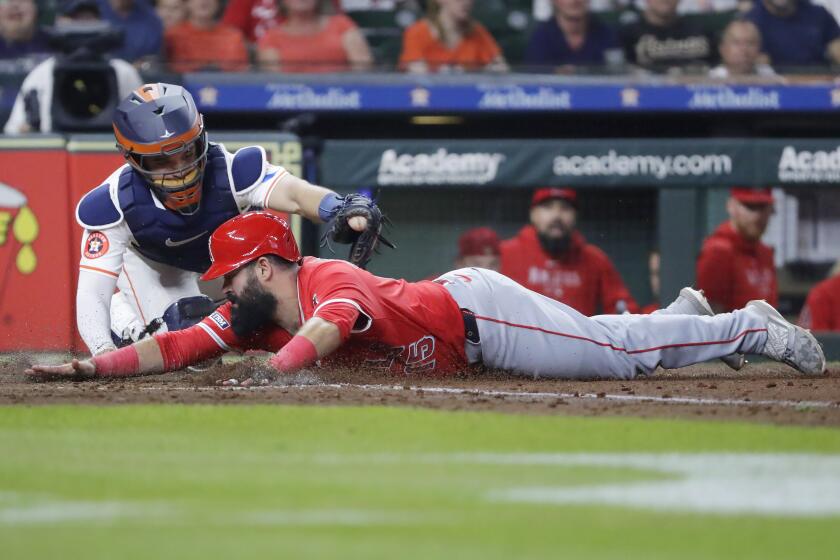Gun Blight at the O.K. Corral : In Tombstone, Sidearms Are Legal and Brains Are Optional
“Ching, ching, ching” went the spurs as they brushed along the wooden sidewalk outside the O.K. Corral.
Could mean trouble, Doug Clay thought as he sat behind the desk inside. Trouble had a way of finding the O.K. Corral.
The earthy, sweet smell of desert sage blew in as Cecil Frum entered the front office, a sinister presence in his black, silver-studded cowboy hat, black leather vest and cowboy boots. But most menacing of all was the 20-inch Bowie knife and pair of revolvers hanging from his hips.
Clay had seen his type before--the steely eyes, the swagger, the attitude.
He sized him up in one word: Tourist.
This is Tombstone 1996, where for the last four years it has been legal for folks to walk the streets with real guns strapped to their hips.
The statute hasn’t returned the town to the Wild West days of lawlessness and violence. But, over the last few years, it has created some touchy situations in “the town too tough to die.”
“Give someone a couple of shots of tequila and either you’re Wyatt Earp or they are,” Clay grumbled.
Lord knows Clay has seen plenty of wannabe gunslingers with sidearms wanting tours of the famous spot immortalized in the movies “Gunfight at the O.K. Corral” and, more recently, “Tombstone” and “Wyatt Earp.”
Quite frankly, it’s getting a little old.
“I get tired of people coming in here, throwing back their duster, pulling their guns and saying, ‘Ha ha, this is a stickup,’ ” said Clay, who manages the infamous site. “There’s nothing funny about looking down the barrel of a .45.”
Since the law took effect, one young man practicing his fast draw shot off his rear-end. Another man, dressed as a gunslinger, put a gun to a woman’s back in the O.K. Cafe. It was just a joke, he said. But she didn’t think so; she punched him in the belly and pressed charges.
Even the stagecoach, which gives 15-minute tours of town, was held up by a drunkard--again, a joke.
But Marshal Bobby Gerencser, who considers himself “more as an Andy Griffith than a Wyatt Earp,” finds nothing funny about it.
“When they see a police officer in town, they think they can draw down on them like the Wild West,” Gerencser said. “He may think it’s fun and games and draw down on me, and it won’t be fun and games. When we pull our weapons, we’re pulling them for a reason.”
Gerencser’s 19th-century predecessor, Marshal Virgil Earp and his famous brother, Wyatt, weren’t laughing either 115 years ago. In those shoot-’em-up days, cowboys and cattle rustlers were taking over the town. One of them shot Marshal Fred White dead on Allen Street.
When Virgil Earp took over as marshal, he instituted a city ordinance banning people from carrying guns in the city limits. Cowboys were required to check their guns at their first stop in town, be it a saloon or a barbershop.
Defending that law led to the notorious gunfight at the O.K. Corral, a livery stable and corral in town. The Earps and Doc Holliday showed up at the vacant lot next door on Oct. 26, 1881, ostensibly to disarm the Clanton and McLowery boys, who were violating the ban.
The rest is history. In a 27-second shootout, Billy Clanton and Frank and Tom McLowery fell dead. Wyatt was the only one in the Earp party to escape injury.
An article in the Tombstone Epitaph the next day concluded that the shootout should serve as a lesson to “teach the cowboy element that they cannot come into the streets of Tombstone in broad daylight, armed with six-shooters and Henry rifles, to hunt down their victims.”
The so-called Virgil Earp Law has remained on the books for more than a century, although enforcement waned when the Earps left town in 1882.
But that changed in the late 1970s, after a Pennsylvania man wearing two pearl-handled revolvers and bandoleers of ammunition crisscrossing his chest called Marshal Gordon Fishler outside for a gunfight.
The incident was resolved without gunfire, but the City Council resurrected the Virgil Earp law.
In 1991, three men challenged it, including Jack Fiske, now a 48-year-old bounty hunter. He complained he was being harassed by local police for carrying his guns--loaded or not. Relations got so bad, he said, that police even cited him for not having lights on his horse when he rode home late one night after drinking at Big Nose Kate’s saloon.
The National Rifle Assn. came to his aid, and the city backed down. The NRA argued that Arizona state law, which allowed people to openly carry guns without a permit, superseded Tombstone’s ban.
Arizona is one of 24 states that allow people to openly carry firearms, according to the NRA.
Most people in those states don’t exercise the right because it’s either cumbersome to carry a gun openly or it overly advertises the fact, NRA spokeswoman Mary Sue Faulker said.
But 31 states, including Arizona, now have laws allowing people to carry concealed handguns--making them easy to tote in a purse or under a jacket. Concealing a handgun also acts as a deterrent to criminals, Faulker said, because they don’t know who’s armed and who’s not. Only 1% to 4% of adults exercise that right, she said.
Ever since Tombstone repealed the Virgil Earp Law in 1992, the town has been a mecca for the many modern-day incarnations of Wyatt Earp, Doc Holliday, Billy the Kid and the Clanton boys.
Many locals nervously await tragedy. Although they believe in the right to bear arms and own guns themselves, they fear the streets of Tombstone are not the place for them.
In fact, one local group, The Vigilantes, no longer performs mock gunfights on Allen Street. They learned their lesson during one show more than a year ago when a spectator pulled his gun on an actor playing dead.
“ ‘Look, he’s still breathing, I’ll shoot him,’ ” Pete Gomez, a bartender at Legends of the West who watched the incident, remembers the spectator saying. The man was promptly tackled.
Ever since, the Vigilantes perform only in an amphitheater--and guns must be checked at the ticket booth.
Until a year ago, Big Nose Kate’s was checking guns, lining them up on a pegboard behind the bar. Some nights, there would be 30 or 40.
“Tourists from Michigan would come in and check their guns, just like little kids with plastic guns playing cowboy,” said bartender Mike Heying, who bears a striking resemblance to Buffalo Bill Cody.
But Big Nose Kate’s doesn’t allow guns anymore, and neither do a number of Tombstone businesses, which have posted signs forbidding them on the premises.
When tourists come into the O.K. Corral with sidearms--almost a daily occurrence--Clay gives them two choices: “Either leave or I’ll call the marshal’s department. If they give me any trouble, I’ve got a can of pepper spray behind the counter.”
He didn’t have to resort to the spray with Cecil Frum, who huffed and grumbled but left, his knife and guns never vacating their holsters.
“I could see me living in the old West,” Frum said the next day, strolling through town with his wife and 8-year-old son, also dressed in cowboy attire right down to the spurs. “If there was reincarnation, that’s when I was reincarnated from.”
But in this life, Frum lives in Bullhead City, Ariz., and works as a nurse.
“Don’t I look like one?” he asked, still clad in his black leather vest, hat and boots.
His replica Bowie knife remained at his side. But the guns, which he always keeps loaded, were gone. He got tired of being turned away from bars and souvenir shops, so he left them back at the inn.
As he and his son walked away, their spurs went “ching, ching, ching” along the boardwalk. The scent of sage still hung in the air.
More to Read
Get our high school sports newsletter
Prep Rally is devoted to the SoCal high school sports experience, bringing you scores, stories and a behind-the-scenes look at what makes prep sports so popular.
You may occasionally receive promotional content from the Los Angeles Times.






